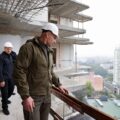
Ukraine’s Primary Housing Market 2025: How War, Construction Delays, and Prices Shape Demand
The current situation in Ukraine’s primary real estate market remains one of the most sensitive to economic and geopolitical challenges. After the full-scale invasion, the market has undergone significant transformation, and even in 2025, the figures are far from pre-war realities. According to experts, the annual demand for new housing is only about 20% of the 2021 level, and in summer, this figure dropped below 15%. The reason lies not only in the state of war and risks, but also in slow construction rates and long delays in putting properties into operation.
One of the biggest obstacles hampering market recovery has become the delays in the completion of new buildings. Real estate market expert Viktoriia Bereshchak explains:
“The average delays on the market are now 18-24 months. This applies to any residential complex. To the date you are promised, you have to add a year and a half. Before the war, this figure was 6-12 months. This does not motivate people to bring money to the sales office.”
Such a situation creates an atmosphere of distrust toward developers. If in the past an investor could expect a relatively short wait, now buyers automatically add another year and a half to the promised timelines, which reduces their desire to invest in new housing.
The Psychological Barrier
An additional factor is psychological stress. People are constantly under the pressure of news about ongoing hostilities, economic instability, and security threats. Viktoriia Bereshchak notes:
“People are constantly on an emotional roller coaster because of events in the world and at the front, which leads to instability in the demand for housing. For example, it traditionally decreases during periods of energy terror.”
Demand noticeably drops during intensified attacks on energy infrastructure or escalations at the front. Buyers have become selective and cautious, investing only where they are confident in the liquidity of the property and minimal risks.
Which Housing Is Selling Most Actively
Despite the overall decline in demand, the highest demand in the primary market is for one-bedroom apartmentswith an area of 45-50 square meters. The exposure time for such housing (the period from listing to closing the deal) is on average 1.5-3 months, while other formats take much longer to sell up to 6 months.
Bereshchak emphasizes:
“In any case, there are buyers. But they are selective and cautious. They will bring money only where they are sure the product is liquid.”
Thus, even in difficult conditions, the market remains alive, but the buyer has changed: they act pragmatically, preferring compact, inexpensive, and liquid housing.
Construction Dynamics and Supply
Construction volumes remain low: in August, only 10 new buildings (13 sections) were commissioned across Ukraine. This is extremely little for a country with millions of displaced people and constant housing demand. Most active completions are in Kyiv, Lviv, and Khmelnytskyi regions. In frontline regions, such as Sumy or Zaporizhzhia, activity is minimal, although prices are rising due to supply shortages.
Sales departments continue to operate in most new buildings, but supply still outweighs demand. Earlier, market analysts recorded that the demand for primary housing is twice as low as supply in other words, it’s getting harder to sell, and developers are forced to look for new incentives.
Pricing: Growth Even in Risk Zones
Prices for new housing in Ukraine have risen in most regions, and most of all in the capital. The average cost per square meter in Kyiv reaches $1,401/m², making it the most expensive market in the country. Meanwhile, the cheapest housing is in frontline cities, such as Sumy or Zaporizhzhia, but even there prices are rising due to demand and limited supply. For instance, in Sumy the increase is 4% ($563/m²), in Zaporizhzhia 20% ($614/m²).
Analysts note that in August, the number of buyers of new apartments in Sumy grew by 62% this is the highest figure in Ukraine. But even with such growth, demand in this region still remains low due to proximity to the war zone and the border with the aggressor country.
Why the Market Isn’t Recovering Faster
The main barriers to recovery are construction delays, war, price increases, psychological uncertainty, and the selectivity of buyers. Analysts separately stress: despite a rise in the number of deals in some regions, the market hasn’t returned to pre-war levels, and demand remains twice as low as supply.
New government programs like “yeOselya” allow certain categories of buyers to reduce the initial down payment, but this does not generate mass demand in the market.
The primary real estate market in Ukraine in 2025 is a space of limited opportunities, high risks, and restrained hopes. Buyers have become cautious and pragmatic. The greatest demand is for compact housing in major cities, while the industry itself is operating at the edge of its capacity due to slow construction and instability.
As Viktoriia Bereshchak sums up:
“This does not motivate people to bring money to the sales office.”
Despite small positive dynamics in certain segments, the market needs predictability, guarantees, and new solutions. For now, this is a market of expectations, not a market of stable demand.














